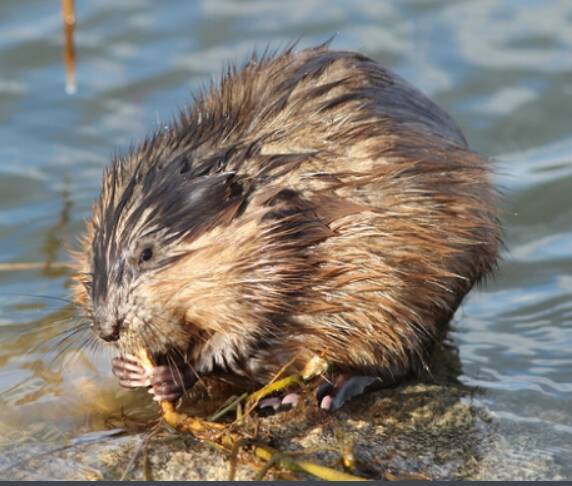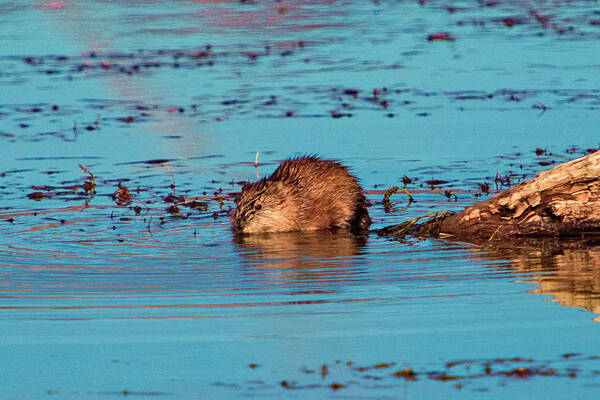Ondatra zibethicus
IUCN
LCBasic Information
Scientific classification
- name:Ondatra zibethicus
- Scientific Name:Ondatra zibethicus,Muskrat, Ondatra,Castor zibethicus Linnaeus,Blue-rooted marten, muskrat, water rat, water rat
- Outline:Rodents
- Family:Rodentia Cricetidae Muskrat
Vital signs
- length:230-360mm
- Weight:800-1450g
- lifetime:
Feature
It is the largest in the subfamily of voles. The male secretes muskrat scent through the muskrat glands in its reproductive system, which has a strong aroma. Muskrat scent can replace musk as a precious Chinese medicinal material and is also a raw material for making high-end perfumes.
Distribution and Habitat
In China, it is distributed in Northeast China, Inner Mongolia and Xinjiang. Abroad, it is distributed in Russia and Central Asian countries, and has also been introduced to many European countries. Its origin is western North America.
This species inhabits swampy areas with abundant aquatic plants, lakes with abundant plants, ponds, river banks, and even in fish ponds.
Appearance
The tail is 200-270mm long, about 2/3 of the body length. The eyes are small. The base of the tail is round, and the distal end is flattened on the left and right sides, covered with small round scales and sparse black short hairs. The ears are small and hidden in the hair. The hind limbs are semi-webbed, and the soles and toes have light yellow tassel-like setae on both sides. The back of the adult is brown-black to dark gray-brown, and the belly is brown-yellow, with darker chest and abdomen.
Details
Muskrat is commonly known as blue-rooted marten or muskrat. It is named because the glands in its perineum can produce musk-like secretions. Because they live in water and are good at swimming, they are also called water rats or water mice. Muskrat is native to North America and was introduced to the former Soviet Union in 1927. The populations in Northeast my country, Inner Mongolia and Xinjiang were migrated from the former Soviet Union. The population of this species in the suitable habitats of Northeast China and Xinjiang is very large, which has threatened indigenous species such as water hyenas and beavers. Measures need to be taken to properly control the population.

Muskrats live on land and can swim and dive in water. They are semi-aquatic mammals. They live mostly in river bays, river branches, shallow small lakes (about 0.3-1 meter deep) where reeds, cattails and other emergent plants grow in clusters, water flows gently, and are suitable for building nests, as well as marsh meadows with perennial water accumulation and ponds (commonly known as "water bubbles"). They build caves on the shore where the soil is suitable for building caves; they build nests in areas where it is difficult to build caves, such as reed ponds or swamps.
Muskrats often live in low-lying areas, swamps, lakes, rivers, and ponds, where there are lush aquatic plants and a quiet environment. Their caves are mainly distributed on the shore, in the shallow water reeds and cattail grass, and some nest on objects floating on the water. The caves are branched, with many blind paths forking, among which there are several granaries, storing feed and several passages leading directly to water.
Muskrats are highly adaptable and are not very demanding on temperature and humidity. They can survive and reproduce in China's cold northeast and arid northwest regions, and can also settle in the humid and warm, or even hot, areas of the south. Muskrats live in wetlands, including ponds, lakes, swamps, and riverbanks, earning them the nickname "swamp squirrels." They are good swimmers, and in the water, they use their tails to propel themselves. Although they resemble beavers, their tails are smaller and thinner than the beaver's distinctive leathery tail. They are found in Alaska, Canada, the United States, and northern Mexico. Muskrats dig large tunnel systems near water sources and make an entrance under the water. In swamps, muskrats use cattails and mud to build their dens and even platforms for transporting food. Muskrats living in beaver dens are also common. Muskrats help maintain the marshland that provides habitat for aquatic animals.
Although muskrats are well-suited for swimming and diving, they are not very mobile on land, so they are active mostly at dusk and at night. The water bodies where they live often have plants that have been bitten off and float on the water surface, and near the runways they pass on the shore, there are piles of 20-30 mm long dark green feces.
Muskrats are mostly active near dawn, dusk, and at night. Male muskrats use a strong muskrat secretion to indicate their identity and to mark territory. Muskrats love to move, but because they are relatively fat, have short limbs, and lie prone on the ground, their range of activity is relatively small and relatively fixed. They are very regional, and the time, frequency, and route of their activities are also regular.
Muskrats love to swim, move freely in the water, and have strong diving ability. They can stay underwater for 2 minutes without showing their heads. If they encounter an enemy, they can stay underwater for 5 minutes without breathing, and the longest can reach 7 minutes. They can swim 20-35 meters per minute. They are mostly in shallow water in summer and in deep water in autumn and winter. Muskrats are aggressive and their movements are relatively hidden. Generally, it is difficult for rats from different families to get along with each other, and they are mostly grouped by blood relationship. When fighting fiercely with the enemy, they often do not hesitate to suffer casualties. Muskrats have a very dull vision and sense of smell, but their hearing is very sensitive.
They eat cattails and other aquatic plants, freshwater mussels, frogs, freshwater crayfish and small turtles. They are prey to weasels, foxes, coyotes, wolves, lynxes and great owlets. Their powerful incisors protrude from the mouth and they chew a lot of roots, buds and fruits of emergent plants. They also eat willow buds and fruits from nearby crops and orchards. They also eat fish, shellfish in the water and snails on the shore.

In areas where it is difficult to build a cave in a reed pond or swamp, before giving birth in May each year, reeds and other emergent plants are bitten off to form the bottom, and then the roots, stems and leaves of the reeds are rolled in mud in bundles, and piled up in a spiral shape to about half a meter to build a nest. There is an underwater tunnel at the bottom of the nest. This nest made of grass and mud is quite strong after it dries. In rural areas of Northeast China, there are grain depots built with grass and mud. Locals call this building material "Lahe braids", which are very durable and can't be blown down by the wind. The newborns are laid in the nest, and the newborns are wrapped in soft grass balls to keep them warm. The adult animals build 1-2 more nests nearby to form a nest group. In September, in order to survive the winter, the caves and nests are expanded on the basis of the summer nests. Generally, 2-5 oval nests can be built, which can also be expanded into warehouses. The nests can keep warm and expand the feeding area in winter. Muskrats sometimes drill into ice holes to prey on fish, frogs and mollusks. These animal foods are high in calories and help muskrats keep warm.
Female muskrats usually have 2 to 3 baby muskrats in one litter. Each muskrat group will have a period of 6 to 10 years when it rises and falls suddenly. In Heilongjiang Province, muskrats give birth to two litters a year. The first one is at the end of May and the second one is at the beginning of August. The gestation period is about one month, and each litter has 5 (2-10) pups. Newborn pups are hairless and have their eyes closed. They grow hair after about a week, and open their eyes after about two weeks. The pups grow fast, and can live independently and find food by themselves in more than a month. The pups are not sexually mature that year, and they will participate in reproduction in the second year. However, in Gongnaisi, Xinjiang, located south of 44°N, the climate of the muskrats is warmer than that of Huma County, Heilongjiang Province, which is north of 50°N. They produce 2-3 litters each year. Although male pups do not participate in reproduction that year, female pups are exceptions. Some female pups that year were estimated to be born in April, and there were 7 embryos on July 2.
Muskrat fur is also known as blue-root mink fur. It has a thick undercoat, bright needles, a strong, tough, wear-resistant and soft leather, thick and soft undercoat, and shiny needles. It can be made into high-end fur coats, fur hats, fur collars, leather gloves, etc., which are light, gorgeous, beautiful and generous to wear. The advantage is that it has strong drainage and is not stained by rain or snow. Muskrat fur is of good quality. The fur is smooth and shiny, and the fur color is like that of an otter. The undercoat is thick and has good thermal insulation. The leather is strong and suitable for making fur hats and collars. China produces a high amount of furs annually. In Heilongjiang, the annual output is about 120,000 pieces; in Xinjiang, the annual output is 250,000 pieces. If combined with the development of processing industry, it has great development prospects. At present, although the fur is soft, it has a peculiar smell that is difficult to eliminate. Although this is a common problem in fur making, it needs to be solved by absorbing advanced science and technology to improve economic benefits.
Muskrat scent glands can be used to extract spices, which can be used to make natural and pollution-free cosmetic raw materials. It can replace musk as a precious Chinese medicinal material and is also a raw material for making high-end perfumes. Muskrat scent contains ingredients such as normusk ketone and heptadecacycloalkanone. In addition to having the same effect as natural musk, it can also prolong the blood coagulation time and prevent and treat thrombotic diseases. Oils and fats can be used to make soap, leather and tableware coatings, fuels and additives in the paint industry.
Listed in the IUCN Red List of Threatened Species in 2017 ver3.1 - Least Concern (LC).








